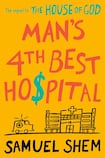
Sequels rarely outshine the original. This is true of Samuel Shem’s Man’s 4th Best Hospital, the 40-years later follow-up to The House of God. But, gosh, it comes very close to the brilliance of his 1978 opus.
The House of God was based on the author’s experiences as an intern at the Beth Israel Hospital in Boston in 1973-1974. He and his colleagues were influenced by the civil rights movement, an influence that fostered a belief in their ability to change things for the better. Reading it became a rite of passage for junior doctors around the world, as they grappled with the brutal reality of 100-plus-hour working weeks.
The House of God outlined 13 rules or universal truths of the hospital as seen through the eyes of intern Roy Basch and his senior resident, the Fat Man, who offers a counterweight of hope and humanity to the intern’s disconnected world. On face value, many of the rules are brutal and continue to be taken literally by impressionable students and physicians – accepted as perfect truth rather than satire. And while its striking satirical aphorisms may explain the book’s continuing popularity, its longevity is also, sadly, due to how dysfunctional medical systems have remained in the intervening years.
Dr Stephen Bergman (Samuel Shem was a protective pseudonym) updates the reasons for the global malaise affecting modern health systems in Man’s 4th Best Hospital. Where once doctors wrote patient notes in paper charts and had the time to chat with their fellow humans, they are now slaves to the electronic medical record (EMR) and there is relatively little time for patient contact.
Non-physician executives
Bergman says he is “more appalled now . . . by the way house staff [junior doctors] are forced to spend much of their time at computers, by the fact that patients have no idea that electronic health records are designed to optimise billing and insurance payments rather than their care, and by the way non-physician executives at the top of hospital systems, having never been trained in patient care, dictate the terms of the profession”.
The interns we met in the original are back in the sequel: now veteran medics they are brought together by their former mentor, the Fat Man, to teach a new generation of interns. They are also determined to fight the corporate greed that has led a venerable institution to drop down the rankings, as it haemorrhages prestige and money.
A large part of the problem is the dehumanisation of physicians in their new role as maintainers of electronic medical records. Bergman once again nails where medical care has lost its way: doctor “burnout” is increasing in line with patients’ dissatisfaction.
But there are gallons of House of God quality humour to help the bitter medicine go down: a good doctor today, the author says, is one “who can contort his or her body to touch-type while still making eye-contact with the patient”.
Inappropriate treatment
And in a powerful takedown of the malignant hospital electronic health record, the Fat Man intervenes just in time to save the life of an older woman whose perilously low blood platelet count is caused by inappropriate treatment. This he achieves by listening to the patient, something the hot shot residents, completely obsessed with graphs of test results on the EMR, deem unnecessary.
“The bad news is that we almost killed her with our ‘care’; the good news is that we saved her from our care. It’s called iatrogenica imperfecta,” the Fat Man observes as they review the close shave.
Bergman loves his acronyms. From the irreverent Gomers (get out of my emergency room) in the original to a new clinic, the FMC (future of medicine clinic) – which just happens to also spell out Fat Man Clinic – in the sequel, acronyms are key to the books’ satire. And the genteel sounding and outwardly patient friendly Heal (Healthy Electronic Assistant Link) turns out to be a tool to maximise patient billing in the highly monetised medical assembly line.
But behind the fictional prose lies a stark reality: doctors now spend two hours documenting computer records for every hour they spend face-to-face with patients.
As writer and medical reformer Dr Atul Gawande noted in a 2018 New Yorker piece “Why Doctors Hate their Computers”, one of the strongest predictors of burnout was how much time a doctor spent tied up doing computer work.
“I began to see the insidious ways that the software changed how people work together. They’d become more disconnected; less likely to see and help one another, and often less able to.”
Sadly, the dangers to patients laid bare in this satire apply in equal measure to Ireland’s two-tier health system. Burnt-out doctors and unfit-for-purpose EMRs now await you and your family when you access modern medical care. As Bergman observes in this fine book, it’s time “we put the human back in health care”.











